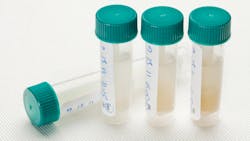Spit matters: Collecting critical data in the quest for oral homeostasis
We are expected to stay on time, keep patients happy, provide exemplary clinical services, and create value for recommended treatment. The struggle is real.
Add to this list the following patient responses:
• “My insurance says I don’t need that done.”
• “I don’t have the time or money.”
• “Can’t you just make my teeth white?”
• “My insurance says your fees are too high.”
• “I just want my free cleaning.”
• “I’ll schedule that later.”
• “I don’t have dental insurance, so I can’t do that.”
• “But the other doctor says I’m just fine.”
Accurate data collection takes up a lot of valuable appointment time. Does every patient appreciate or understand why we take radiographs, record blood pressure, review medical histories, update periodontal charts, take intraoral photographs, and chart existing restorations, suspicious areas, carious lesions, or soft-tissue anomalies? The obvious answer is no. There are many who just want to get their teeth cleaned and look upon these tasks as unnecessary, time-consuming, and a way to generate another billable fee.
Again, the struggle is real.
Value of a baseline salivary assessment
Optimal oral health is the goal, and an adequate amount of healthy saliva is necessary to support this objective. Healthy saliva plays a critical role in the prevention of caries, erosion, dentinal hypersensitivity, and fungal infections.1 Adequate saliva is a key quality-of-life issue. Dry mouth increases the risk for compromised nutritional intake, sleep disturbances, and difficulty in talking, and it sets the stage for soft-tissue discomfort and can contribute to low self-esteem. Dry mouth is not age dependent. It can be a direct result of medications, disordered breathing, lifestyle issues, pathology, or a combination of these factors.2
Despite the fact that we understand the value of saliva, does your practice have a process in place to collect information about the quality and quantity of a patient’s saliva? Or instead, is the practice’s risk protocol based on a quick visual inspection coupled with a patient’s reply to a few general questions?
Insufficient or unhealthy saliva sets the stage for disease.1,2 While salivary disfunction issues typically increase with age, children, adolescents, and young adults are not immune to this condition.3,4 Patients of all ages should have baseline salivary testing.
In today’s world, a visual inspection and a few questions simply fall short of what oral health-care providers can do for their patients. There is often a significant reduction in salivary flow before the conversation ever comes up during a dental visit. Salivary changes can be subtle over time.2 A subjective question such as, “Do you feel that you have a dry mouth?” may not uncover the real issue. A patient may not be able to provide a true answer that truly quantifies their risk. A more accurate picture emerges from the answers to questions such as these:
• “Do you wake up with a dry mouth in the middle of the night?”
• “Do you have problems tasting food?”
• “Do you have to sip liquid to swallow food comfortably?”
• “Does your tongue ever feel like it is burning?”
• “Does your mouth feel dry or taste bad first thing in the morning?”
Missing data points—salivary testing
Various saliva tests can provide a wide range of useful, objective information. Sharing these findings can motivate a patient to either modify a current behavior or adopt a health-generating protocol. Testing can reveal the chemical quality of the saliva (pH and buffering capacity), the quantity (resting and stimulated flow),5-9 and information about the microbial composition (bacterial and fungal).7-15
There are specific reasons for gathering each type of data, and different tests are used to gather targeted information. In addition to salivary testing, intraoral photos provide a unique, visual record of soft-tissue color and texture, and whether the tissue appears moist or parched.
Salivary pH and buffering capacity
Healthy resting saliva, also known as unstimulated saliva, falls in a pH range of 6.8 to 7.2. In today’s world, it is not unusual for a patient to test from pH 6 to pH 6.5 or even lower. While not common, the reading can dip as low as 5, and occasionally pH testing will reveal rates as high as 7.5 or even 8. The lower the pH, the higher the risk for caries, erosion, dentinal hypersensitivity, and Candida infections.5-9 Lower pH ranges are found in those with dry mouth syndrome as well as people who frequently consume sugary or starchy foods or who have a high intake of acidic foods and beverages.
It is very easy to test salivary pH. Collect fresh saliva in a small disposable cup. Dip the pH test strip into the saliva or place the strip directly in the mouth. Immediately match the color change against a test grid and record the finding.2
While understanding pH is important, buffering capacity is another valuable data point. If salivary bicarbonate and phosphate ion levels are insufficient, one can have a perfectly normal pH range but still lack the chemical ability to neutralize oral acids.2,16 Relative buffering capacity can be determined using a chairside test that classifies the saliva buffering range as very low, low, or normal.2
A unique test strip, called Cavity pHighter, combines pH and buffering testing in one strip. A test strip moistened with saliva reveals both the pH level and the relative buffering capacity. Not only can dental professionals gather this data during an office visit, but patients can now monitor their oral pH and buffering on a regular basis at home using this cost-effective method. This product can improve patient engagement, further reinforce the value of testing, and support subsequent therapeutic recommendations.
Understanding pH and buffering can help solve mysteries. It is not uncommon for two children in a household who have identical dietary intake patterns and oral hygiene regimens to also have wildly different caries risk levels. In this situation, it is wise to consider an underlying breathing disorder that may be creating dry mouth issues in one of the siblings.
Flow rates
On average, people produce between 0.5 and 1.5 liters of saliva per day. Just as white coat syndrome can cause a spike in a patient’s blood pressure reading, relying on how much saliva appears to be present during a dental appointment is not a true measure of salivary flow rates. Of the two types of flow—resting and stimulated2,5-6—both types provide valuable information. A resting flow is most common at nighttime, and this can be quite low for high-risk patients. Stimulated flow occurs throughout the day and can be triggered by visual stimuli, talking, chewing, and smelling food.2
A visual inspection can reveal the resting flow rate. Retract the lower lip. Dry with a piece of gauze. Record the amount of time it takes for small drops of saliva to appear on the labial mucosa and saliva to pool under the tongue. Less than 30 seconds reveals a high flow rate, 30 to 60 seconds is normal, and more than a minute is considered a low flow rate. Normal saliva is watery and clear, while frothy, bubbly, or sticky saliva indicates increased viscosity.2
The next test measures the stimulated flow rate. Have a patient chew a piece of unflavored wax. Advise the patient to expectorate every 15 to 20 seconds into a collection cup for a period of five minutes. The total volume of saliva can be used to measure the stimulated flow rate. A normal stimulated flow rate will be 5 mL or greater. A low rate is 3.5–5 mL, and less than 3.5 mL is classified as very low.2
GC America’s Saliva Check Kit contains all of the supplies you need to conduct these tests: pH, buffering, and flow rates. This is an ideal and affordable way to gather preliminary baseline data. And the data collection can be performed by any member of the dental team.
More sophisticated in-office salivary tests
The BokaFlo (Boka Sciences) is an FDA-registered screening device testing protocol that accurately and objectively provides a more precise data point of resting saliva flow rate. After swallowing all of the saliva in the mouth, a small sponge is placed under the tongue for three seconds. The weight is recorded on a scale. The patient is then instructed to sit quietly and not swallow for one minute. A second sponge is placed under the tongue for three seconds and then weighed. The weight differential determines the whole resting salivary flow rate.
SiLL-Ha testing (Arkray Dental) is the most comprehensive in-office saliva test available today. SiLL-Ha testing provides seven individual data points that indicate known caries and gingivitis risk factors, in addition to an ammonia score to measure oral cleanliness. Caries risk measures include acidity, buffering capacity, and the cariogenic bacterial load. Gingival health risk includes quantifying blood, leukocytes, and protein levels. The information can be tracked over time to reveal salivary changes.
The process is simple. A patient gently rinses with a 3 ml testing solution for 10 seconds, and then expectorates the contents into a paper cup. Individual drops of the test fluid are placed on each SiLL-Ha test strip square. The strip is placed in the SiLL-Ha device for five minutes, and the results are stored in either a Windows or Mac computer platform. A printed report can be generated that shows the most current data as compared to previous tests. This concept map includes simple explanations for each data point. SiLL-Ha provides a tool to monitor progress and fine-tune recommendations as the patient’s salivary profile changes.
Testing for specific caries microbes
Many microbes are involved in the caries infection process. OralDNA Labs offers two salivary tests that make it easy to identify the presence of specific caries bacteria as well as fungal organisms.
High levels of Streptococcus mutans,8-10 Streptococcus sobrinus,10 and Lactobacillus casei7,8 are often implicated as key caries bacteria. Candida albicans is an opportunistic fungal pathogen that can be the underlying cause of burning mouth syndrome. Candida is also found in severe caries infections, most particularly early childhood caries.13,14,16 All four microbes are acidogenic, a classification characterized by heavy acid production and the ability to survive and thrive in a low pH. Testing is particularly helpful when clinicians are trying to determine a patient’s microbial risk for caries.
Salivary testing—the urgency
Dental professionals who have accurate data to support a diagnosis and potential treatment plan are providing a true service for those who seek our care.
As we become more and more aware about the importance of saliva, it is critical to have a baseline for as many data points as possible. In addition, it is necessary to reevaluate data points periodically to look for changes. The actual interval should be based on individual patient risk factors.
Is it wise to embark on a major restorative case when dry mouth issues are either not discussed or documented? The answer is simply no; ethically, salivary diagnostics should be an integral step in patient examination protocols. The medical community requires practitioners to use appropriate data to support a treatment plan. Why are we not doing the same?
If altruism is not a sufficient motivator, consider the day the legal community learns dry mouth syndrome is a significant caries risk factor and that salivary testing has been available for decades.
Accurate testing using scientific methods can deliver important data. Evidence-based decision-making requires that we interpret data to formulate potential treatment plans. In addition, health plan providers expect exacting metrics from both a diagnostic and reimbursement standpoint. The days of making a snap judgment about saliva are over. It is time to get the data and get it right.
Setting the stage for success
Saliva testing is not difficult. To ensure success, it is important that everyone in the practice understands the value of salivary testing from a diagnostic standpoint. Along with more accurate diagnostics, accurate data impacts how the team can support prevention protocols or treatment recommendations. It is important for everyone to be familiar with the following aspects of salivary testing:
- The different types of tests
- Specific information or data derived from each test
- Patient classifications—i.e., who will benefit
- Testing frequency
- Location and storage of testing supplies
Other considerations include:
- Who determines which tests will be performed?
- Where will the data be recorded?
- What therapies or recommendations will be implemented based on the data?
- Will there be a fee charged for data collection?
- When are the tests performed?
- Who is responsible for the testing?
- How often will the testing be conducted?
- When should additional tests be implemented?
- What are the diagnostic codes for salivary testing?
- Can the diagnostic codes be used in a dental benefit plan or submitted to a medical insurance plan?
- How will salivary diagnostic findings be communicated to the patient’s medical providers?
Testing resources
- BokaFlo Testing: https://bokasciences.com/why-use-bokaflo/
- Cavity pHighter Test Strips: https://caogroup.com/collections/cavity-phighter
- Hydrion pH paper (5.0–9.0): https://www.microessentiallab.com/ProductInfo/F60-WIDRG-050090-VPS.aspx
- pH ID (oral pH strips): https://forwardscience.com/phid
- Saliva-Check Buffer Kit test directions: http://www.gcamerica.com/products/preventive/Saliva_Check_BUFFER/Saliva_Check_TestingMat.pdf
- SiLL-Ha Salivary Testing Instrument: https://arkraydental.com/flow/index.html
Author’s note: The author wishes to thank Brian Nový, DDS, FADI, for his scientific review of this manuscript.
References
1. Mandel ID. The functions of saliva. J Dent Res. 1987;66(suppl 2):623-627. doi:10.1177/00220345870660S203.
2. Sreebny LM, Vissink A. Dry mouth—The Malevolent Symptom: A Clinical Guide. Wiley-Blackwell; 2010.
3. Thomson WM, Lawrence HP, Broadbent JM, Poulton R. The impact of xerostomia on oral-health-related quality of life among younger adults. Health Qual Life Outcomes. 2006;4(86). doi:10.1186/1477-7525-4-86.
4. Sørensen CE, Hansen NL, Mortensen EL, Lauritzen M, Osler M, Pedersen AML. Hyposalivation and poor dental health status are potential correlates of age-related cognitive decline in late midlife in Danish men. Front Aging Neurosci. 2018;10:10. doi:10.3389/fnagi.2018.00010.
5. Pyati SA, Kumar NR, Kumar V, Kumar NHP, Reddy KMP. Salivary flow rate, pH, buffering capacity, total protein, oxidative stress and antioxidant capacity in children with and without dental caries. J Clin Pediatr Dent. 2018;42(6):445-449. doi:10.17796/1053-4625-42.6.7.
6. Jager DHJ, Bots CP, Forouzanfar T, Brand HS. Clinical oral dryness score: evaluation of a new screening method for oral dryness. Odontology. 2018;106(4):439-444. doi:10.1007/s10266-018-0339-4.
7. Martínez-Pabón MC, Ramírez-Puerta BS, Escobar-Paucar GM, Franco-Cortés AM. Physicochemical salivary properties, Lactobacillus, Mutans streptococci counts and early childhood caries in preschool children of Colombia. Acta Odontol Latinoam. 2010;23(3):249-256.
8. Gudkina J, Brinkmane A. Caries experience in relation to oral hygiene, salivary cariogenic microflora, buffer capacity and secretion rate in 6-year olds and 12 year olds in Riga. Stomatologija. 2008;10(2):76-80.
9. O’Sullivan EA, Curzon MEJ. Salivary factors affecting dental erosion in children. Caries Res. 2000;34(1):82-87. doi:10.1159/000016574.
10. Agnello M, Marques J, Cen L, et al. Microbiome associated with severe caries in Canadian First Nations children. J Dent Res. 2017;96(12):1378-1385. doi:10.1177/0022034517718819.
11. Fakhruddin KS, Ngo HC, Samaranayake LP. Cariogenic microbiome and microbiota of the early primary dentition: A contemporary overview. Oral Dis. 2019;25(4):982-995. doi:10.1111/odi.12932.
12. Tanner ACR, Kressirer CA, Rothmiller S, Johansson I, Chalmers NI. The caries microbiome: implications for reversing dysbiosis. Adv Dent Res. 2018;29(1):78-85. doi:10.1177/0022034517736496.
13. Gábris K, Nyárasdy I, Bánóczy J. [Significance of assessing risk factors for caries in their prevention]. [Article in Hungarian] Orv Hetil. 2002;143(24):1467-1473.
14. Xiao J, Grier A, Faustoferri RC, et al. Association between oral Candida and bacteriome in children with severe ECC. J Dent Res. 2018;97(13):1468-1476. doi:10.1177/0022034518790941.
15. Gomar-Vercher S, Simón-Soro A, Montiel-Company JM, Almerich-Silla JM, Mira A. Stimulated and unstimulated saliva samples have significantly different bacterial profiles. PLoS One. 2018;13(6):e0198021. doi:10.1371/journal.pone.0198021.
16. Zabokova Bilbilova E, Sotirovska Ivkovska A, Georgiev Z, Stefanovska E. Evaluation of buffer capacity of saliva in caries-free and caries-active children. Pril (Makedon Akad Nauk Umet Odd Med Nauki). 2013;34(2):151-157.
About the Author
Anne Nugent Guignon, MPH, RDH, CSP
ANNE NUGENT GUIGNON, MPH, RDH, CSP, has received numerous accolades over four decades for mentoring, research, and guiding her profession. As an international speaker and prolific author, Guignon focuses is on the oral microbiome, erosion, hypersensitivity, salivary dysfunction, ergonomics, and employee law issues. She may be contacted at [email protected].


